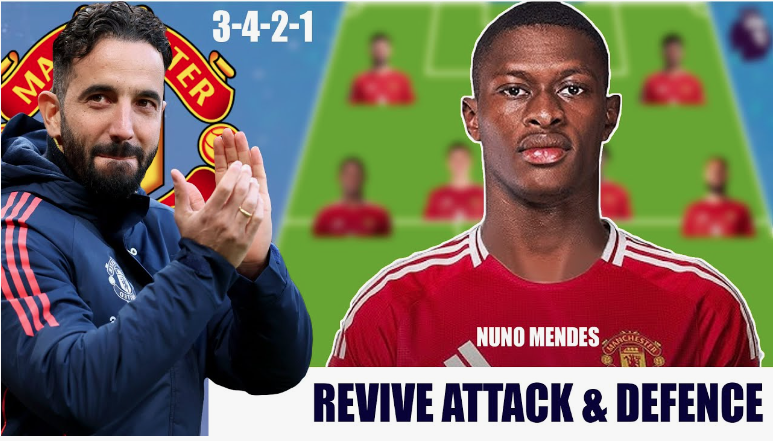Signs of Progress Under Ruben Amorim: A Turning Point for Manchester United?
Signs of Progress Under Ruben Amorim: A Turning Point for Manchester United? When Ruben Amorim warned of an impending “storm,” even he might not have predicted the scale of turbulence that followed in December. Six defeats in 11 games marked Manchester United’s worst managerial start since 1932. However, a spirited draw at Anfield has provided a glimmer of hope, showing signs of a more cohesive and tactical approach under Amorim.
While it’s too soon to declare the storm over, this performance offers a template for the Red Devils moving forward. Let’s examine what has changed – and what hasn’t – since Amorim’s appointment on November 11. What’s Wrong with Manchester City? Unraveling Their Worst Slump in Years
Tactical Challenges: Time to Train vs. Execution Issues
Amorim has overseen nine Premier League matches, matching Erik ten Hag’s earlier stint this season. The results, however, are less than encouraging:
- Points Earned: Eight (compared to Ten Hag’s 11).
- Possession: Increased slightly from 53% to 55%, but defensive and attacking efficiency has worsened.
These struggles are evident in United’s performance in Amorim’s preferred 3-4-3 formation. The team often appears disjointed, with ineffective pressing leading to decompressed lines. Key metrics also reflect this:
- High Turnovers: Dropped from 83 to 56.
- Pressed Sequences: Reduced from 128 to 100.
- Distance Run: Declined from 976.2 km to 966.5 km.
The reasons could include a lack of training time to instill high-energy pressing patterns or an unsuitable squad for Amorim’s possession-based style.
Defensive Adjustments: Stability in the Backline
A key issue has been the inconsistency in defensive selections. Up until the 3-0 defeat against Bournemouth on December 22, Amorim had changed the back three, midfield pair, wing-backs, and forwards for every Premier League match.
However, consistency has emerged as a priority:
- Average Changes per Game: Dropped from four to three since the Bournemouth match.
- Stability in Defense: For the first time under Amorim, United fielded the same back five in consecutive Premier League games.
The result? A more compact defense at Anfield, with reduced gaps between Matthijs de Ligt, Harry Maguire, and Lisandro Martinez. This was critical in thwarting Liverpool’s crosses:
- Liverpool’s Crosses: 0 successful open-play crosses out of 17 attempts – a significant improvement for United.
Midfield: Addressing Structural Weaknesses
The 3-4-3 formation has exposed United’s midfield, particularly in the spaces on either side of the two-man center. This vulnerability peaked during the 2-0 loss to Newcastle, where Joelinton and Bruno Guimarães exploited these gaps to dominate the game.
At Anfield, however, Manuel Ugarte and Kobbie Mainoo provided energy and tenacity, shuttling effectively across the pitch. Key adjustments included:
- Wing-Backs: Played higher up the pitch to compress the midfield.
- Bruno Fernandes: Dropped into deeper midfield roles, helping plug gaps.
This cohesive effort neutralized Liverpool’s midfield dominance and showcased a potential blueprint for future games. The Power of the Anfield Crowd: A Mixed Legacy
Attack: Diallo and Fernandes Shine Amid Tactical Tweaks
Amorim’s philosophy of purposeful, vertical possession has begun to take shape, with Amad Diallo emerging as a standout performer:
- Diallo’s Impact: Involved in eight of United’s 11 Premier League goals under Amorim (3 goals, 5 assists).
- Dribbles Completed: 21, second only to Iliman Ndiaye (25) during the same period.
Dalot’s more aggressive wing-back play and Fernandes’ hybrid role between No. 10 and midfield were also key at Anfield. Dalot’s advanced positioning disrupted Liverpool, while Fernandes played decisive long passes to initiate attacks.
Despite creating 21 chances since Amorim’s arrival (third-highest in the league), Fernandes has yet to fully settle. However, his refined role at Anfield could serve as a turning point for him and the team.
The Road Ahead: A Template for Success
Manchester United’s 2-2 draw at Anfield suggests that Amorim’s vision of a hard-pressing, tactically disciplined team is achievable. Key takeaways include:
- Consistency in Defense: Stability in selections has improved organization and reduced vulnerabilities.
- Midfield Resilience: Ugarte and Mainoo bring energy and structure to a previously porous midfield.
- Effective Wing-Back Play: Aggressive, forward-thinking wing-backs create attacking opportunities while aiding midfield transitions.
- Diallo’s Creativity: Diallo’s form exemplifies the benefits of Amorim’s vertical possession style.
The storm may not have passed entirely, but United’s newfound clarity offers hope. If Amorim can build on the Anfield performance, the Red Devils might finally have the foundation for a successful, coherent project.

